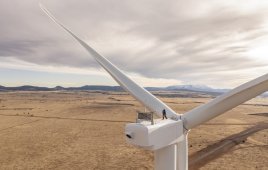Editor’s Note: The following article is from The Switch, a manufacturer of megawatt-class permanent magnet generator and full-power converter packages.
The windpower industry has witnessed fallout from the global economic downturn and the significant geographic shift from Europe and the U.S. toward China and emerging markets. As a result, the industry is opening up to the benefits of networking or collaboration. Large turbine manufacturers are selling off component manufacturing operations to other specialist players. This lets them better compete by concentrating on their core strengths and focusing on bigger turbines and more efficient technology, says Jukka-Pekka Mäkinen, president and CEO of The Switch.

Jukka-Pekka Mäkinen, president and CEO of The Switch, says the wind industry should embrace a collaborative approach.
Why network now?
Industries that have embraced collaboration are now better prepared for fluctuations in the market that come from business cyclicality, market volatility, or even geographical shifts. Networking within industries is not new. The automotive and telecommunications industries, even companies such as elevator manufacturers, have been operating in such a manner for years, gaining benefits from expertise, scalability, and speed. Now the windpower industry is beginning to wake up to the opportunities of networking.
Players in the wind industry, including the Chinese, are suffering from reduced revenue and margins. This has been intensified by current overcapacity in the market. Another reason networking is picking up speed is to overcome the rigidity of vertical integration that still clutches the entire industry, making it difficult if not impossible for the larger, more traditionally operating companies to adjust rapidly to the slowdown.
Furthermore, support for the wind industry is still quite patchy. This is due in part to the continuing doldrums of the economy at large, including the shadow of sovereign debt in some European countries, and in part due to adverse political decisions throughout the world.
Specialization leads to higher quality
“Companies in the windpower industry now need to focus on being good at their chosen core competencies,” Mäkinen says. “Every turbine needs a wide range of components. This requires a high level of know-how from the manufacturer to continue to develop products and maintain turbines in the field. By embracing specialization, it is possible for these manufacturers to tap into cumulative experience, which leads to significantly improved quality.”
Typically, a turbine manufacturer develops components for a new turbine type that are manufactured and installed for years. Resources get tied up with ongoing projects, maintenance, and small improvements, which mean there is not much time left for innovation. Before it’s time to develop a new type of turbine, it is hard for vertically integrated companies to hold on to their best engineering competence. In addition, it burdens them to continue having these excess personnel costs.
In contrast, engineers in highly specialized component companies are continuously focusing on what they do best – designing new types of turbines for the changing market – and staying motivated to innovate the next big thing. Within a short time we have witnessed a transition to new, more efficient technologies such as permanent magnet generators and full-power converters. This also leads to a focus on improving quality, ensuring a world-class solution with bigger and better wind turbines.
“When a company runs into trouble with components that have been manufactured within a vertically integrated organization, the lead engineering team and company management must be engaged in putting out fires or solving routine problems. In a networked or collaborative approach, a specialist can be called in to offer extra resources and solve the problem. In most cases, they have up-to-date knowledge on that specific technology and can usually fix the problem much faster,” Mäkinen says.
Expertise, scalability and speed
A networked approach combines the best of expertise, scalability, and speed. By tapping into experts in a particular area, even from other business areas or other industry expertise, it is possible to gain knowledge and take the entire industry to a new level.
“It is more efficient to use existing knowledge rather than reinventing the wheel,” Mäkinen says. “The experts are the ones, for example, who know the best way to stamp out a piece of metal using the least amount of materials. It makes sense to use them rather than have a company hire their own persons and spend the time to train them.”
Scalability, or being able to ramp up or down rapidly, is another benefit. In the wind industry, this means that a company can develop something new for six months, use it for two years, and then move on to new products, if the market so demands. This gives a company unrivaled agility when it comes to designing new technology and being on the innovative forefront.
Extraordinary speed, too, comes from networking. Specialists have well-tested processes and experienced project management for their components, resulting in predictable timetables. By using suppliers that have a good concept in place for establishing presence in new locations, companies can localize faster and gain a more solid foothold in a new market.
Network as good as its weakest link?
A common concern is that a network is only as good as its weakest link. Asked how to ensure the best performance of the entire network, Mäkinen says: “Communication is key. And communications must work across all borders.”
A turbine manufacturer’s way of working must be thoroughly communicated to all partners in the network so that everything functions seamlessly. One set of quality standards must be selected at the start, even if this is achieved by interlinking the quality systems of different companies. This helps to maximize results throughout the network.
Imposing a company’s best practices on partners in the network is not recommended as this slows the workflow down. Rather, it is more important to understand the partners’ processes for working, along with the methods of measuring quality.
“It takes time perhaps before all partners are up to speed in their understanding of how to work within a network. But once the game plan is established, the results can be exceptional,” Mäkinen says.
Time and risk factors
Some of the main reasons why industries do not move faster towards a networked model, even if they understand all the favorable implications, are because of the time and risk involved.
“The transition, however, is more of a mental shift,” Mäkinen says. “In the end, the companies gain much faster time-to-market with their products and services. Not only does this take courageous business decisions, it also requires mental training from the top management to pave the way for the new and modern way of working throughout the organization.”
Downsides of networking
The only downside that Mäkinen has experienced from the networked model that The Switch uses is the prerequisite that the specialists must constantly be more efficient, bringing a quantifiable amount of added value to all they do.
“Specialists must have sufficient volumes to continuously lower costs and bring higher quality products to the market,” he challenges. “Although this is not easy, this is what drives those individuals who have chosen to be specialists in their field to excel in making a difference in the industry as a whole. And within a global network, they need to be world-class at what they do.”
Advantages for large and small players
Since being established in 2006, The Switch has always operated in a networked approach. At first, this was primarily due to the necessity of doing business with limited resources. As the company grew, the networking model continued to make more sense because the organization could adeptly respond to the volatile changes in the windpower market.
As Jukka-Pekka Mäkinen sees it: “A networked approach gives smaller players the capability to build their products with qualified partners. For large players, networking clearly reduces risk, enables scalability, speeds up time-to-market, and most importantly, lowers their total cost structure.”
“Networking at its best is like an orchestra in which each member is responsible for playing his or her own instrument and melody. The result is a symphony that receives a standing ovation,” Mäkinen says.
The Switch
www.theswitch.com
Filed Under: Components, Turbines




